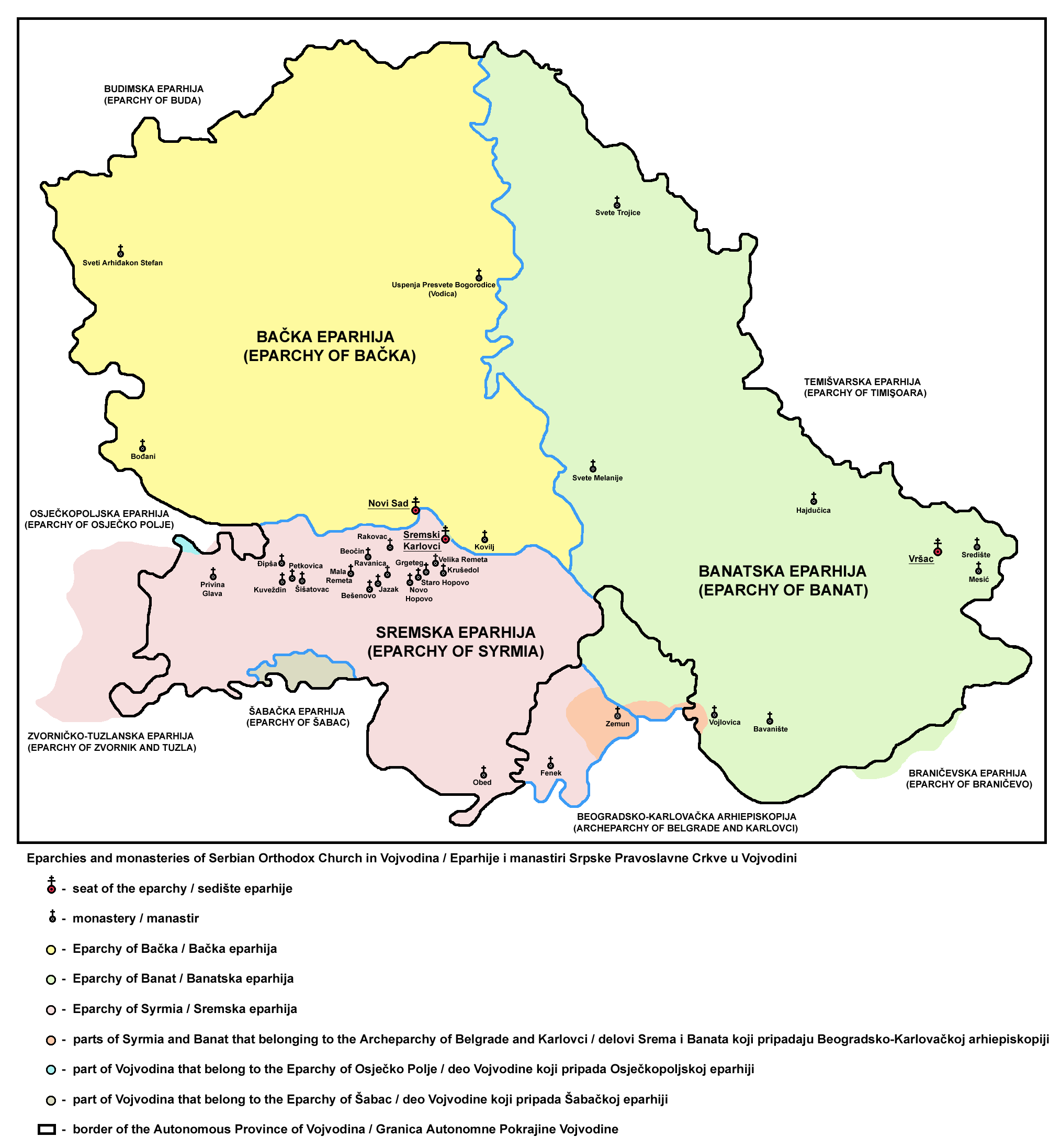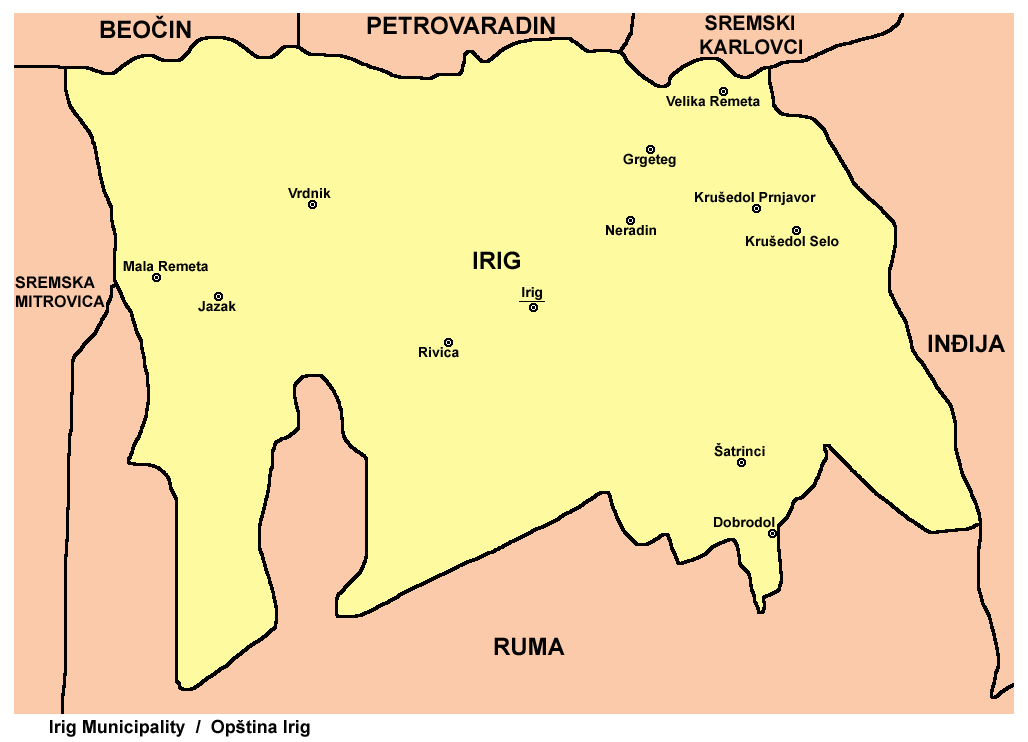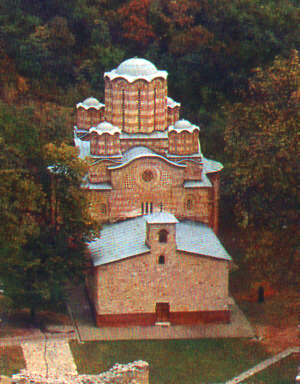|
Vrdnik
Vrdnik ( sr-Cyrl, Врдник; ) is a village located in the municipality of Irig, northern Serbia, in the Vojvodina province of Serbia. It is located at southern slopes of Fruška Gora, at the border of the national park. As of 2011 census, it has a population of 3,092 inhabitants. Name In Serbian the village is known as ''Vrdnik'' (Врдник)and in Hungarian as ''Rednek''. Features Although small, the village has several distinctive features: a thermal spa, Vrdnik-Ravanica monastery from the 16th century, former coal mine with steam power plant built in 1911, but destroyed during NATO bombing of Yugoslavia in 1999, and a ruined castle, known as Castellum Rednek or '' Vrdnička kula'' (Tower of Vrdnik). Geography Vrdnik is placed near the heart of Fruška Gora, in a valley surrounded by its slopes, at elevation of 181–260 m and coordinates . The valley is formed by three creeks named ''Dubočaš'', ''Morintov potok'' and ''Veliki potok''. Most houses are built ... [...More Info...] [...Related Items...] OR: [Wikipedia] [Google] [Baidu] |
Vrdnik-Ravanica Monastery
The Vrdnik-Ravanica Monastery ( sr, Манастир Врдник-Раваница, Manastir Vrdnik-Ravanica), also known as Little Ravanica (Мала Раваница'' / Mala Ravanica''), is a Serbian Orthodox monastery in Vrdnik in the Fruška Gora mountains in the northern Serbia, in the province of Vojvodina. The exact date of its founding is unknown. The records indicate that the church was built at the time of Metropolitan Serafim Jovanović, in the second half of the 16th century. The present church in the monastery was constructed in the period from 1801 to 1811. The icons on the altar screen and the vaults were painted by Dimitrije Avramović in 1853. Vrdnik-Ravanica Monastery was declared Monuments of Culture of Exceptional Importance (Serbia), Monument of Culture of Exceptional Importance in 1990, and it is protected by Republic of Serbia. See alsoMonasteries of Fruška Gora- Fruškać *Monuments of Culture of Exceptional Importance (Serbia), Monument of Culture of Exc ... [...More Info...] [...Related Items...] OR: [Wikipedia] [Google] [Baidu] |
Fruška Gora
Fruška gora ( sr-Cyrl, Фрушка гора; hu, Tarcal-hegység) is a mountain in Syrmia, administratively part of Serbia with a part of its western side extending into eastern Croatia. The area under Serbian administration forms the country's oldest national park. Sometimes also referred to as the ''Jewel of Serbia'', due to its largely pristine landscape and protection effort, or the ''Serbian Mount Athos'', being the home of a large number of historical Serbian Orthodox monasteries. Name In Serbian, it is known as ''Fruška gora'' (, Фрушка гора), in Hungarian as ''Tarcal'' (also ''Almus-hegy'' or ''Árpatarló''), in German as ''Frankenwald'', and in Latin as ''Alma Mons''. In Medieval Greek, it was known as ''Frangochoria''. The mountain's name originates in the old Serbian word ''"Fruzi"'' derived from the singular form ''"Frug"''; and its adjective is ''Fruški'', used for naming the Frankish people. The name of ''"Fruška Gora"'' is ''"Frankish mountai ... [...More Info...] [...Related Items...] OR: [Wikipedia] [Google] [Baidu] |
Irig, Serbia
Irig (, ; hu, Ürög) is a town and municipality located in the Srem District of the autonomous province of Vojvodina, Serbia. The town has a population of 4,415, while Irig municipality has 10,866 inhabitants. Name In Serbian, the town is known as ''Irig'' (Ириг), in Croatian as ''Irig'', in Hungarian as ''Ireg'' or ''Ürög'', in German as ''Irick'', in Slovak as ''Irig'', and in Rusyn as Ириґ. History Irig was first mentioned in the historical documents in 1225. In the 15th century, the masters of the town were Serbian despots Vuk Grgurević, Đorđe Branković, and Jovan Branković. During the 15th and 16th century, ten Orthodox monasteries were built in the surrounding of Irig (Two of those were located just near the town). Between 1526 and 1699, the town was under Ottoman administration. During this time, it belonged to the Sanjak of Syrmia, and was the administrative seat of one of the seven nahijas in that sanjak. In 1665, the town had 2,000 houses, one m ... [...More Info...] [...Related Items...] OR: [Wikipedia] [Google] [Baidu] |
Ravanica Monastery Vr
The Ravanica Monastery ( sr, / ) is a Serbian Orthodox monastery on Kučaj mountains near Senje, a village in Ćuprija municipality in Central Serbia. It was built in 1375–1377 as an endowment of prince Lazar of Serbia, who is buried there. The Ravanica church is called the birthplace of the new artistic movement "Morava school" because of architectural and artistic features. It is original blend of the Mount Athos and the cross-in-square five-domed model that became standard in the time of King Milutin. Ravanica was declared Monument of Culture of Exceptional Importance in 1979, and it is protected by Republic of Serbia. History Built between 1375 and 1377, Ravanica is the famous endowment of Prince Lazar, where he was buried after his death in the Kosovo battle. Since then, Ravanica has been a pilgrim's destination and an important center of cultural activities & assemblies for the Serbian people. The monastery was assaulted and damaged by the Ottoman Turks several ... [...More Info...] [...Related Items...] OR: [Wikipedia] [Google] [Baidu] |
List Of Populated Places In Serbia
This is the list of populated places in Serbia (excluding Kosovo), as recorded by the 2002 census, sorted alphabetically by municipalities. Settlements denoted as "urban" (towns and cities) are marked bold. Population for every settlement is given in brackets. The same list in alphabetic order is in List of populated places in Serbia (alphabetic). A Ada Aleksandrovac Aleksinac Alibunar Apatin Aranđelovac Arilje B Babušnica Bač Bačka Palanka Bačka Topola Bački Petrovac Bajina Bašta Barajevo Batočina Bečej Bela Crkva Bela Palanka Beočin Blace Bogatić Bojnik Boljevac Bor Bosilegrad Brus Bujanovac C Crna Trava Č Čačak Čajetina Čoka Čukarica Ć Ćićevac Ćuprija D Despotovac Dimitrovgrad Doljevac G Gadžin Han Golubac Gornji Milanovac Grocka I Inđija Irig Ivanjica J Jagodina K Kanjiža Kikinda Kladovo Knić Knjaževac Koceljeva Kosjerić Kovačica Kovi ... [...More Info...] [...Related Items...] OR: [Wikipedia] [Google] [Baidu] |
Marcus Aurelius Probus
Marcus Aurelius Probus (; 230–235 – September 282) was Roman emperor from 276 to 282. Probus was an active and successful general as well as a conscientious administrator, and in his reign of six years he secured prosperity for the inner provinces while withstanding repeated invasions of barbarian tribes on almost every sector of the frontier. After repelling the foreign enemies of the empire Probus was forced to handle several internal revolts, but demonstrated leniency and moderation to the vanquished wherever possible. In his reign the constitutional authority of the Roman Senate was fastidiously maintained, and the victorious Emperor, who had carried his army to victory over the Rhine, professed himself dependent on the sanction of the Senate. Upon defeating the Germans, Probus re-erected the ancient fortifications of emperor Hadrian between the Rhine and Danube rivers, protecting the Agri Decumates, and exacted from the vanquished a tribute of manpower to resettle depop ... [...More Info...] [...Related Items...] OR: [Wikipedia] [Google] [Baidu] |
Stream
A stream is a continuous body of water, body of surface water Current (stream), flowing within the stream bed, bed and bank (geography), banks of a channel (geography), channel. Depending on its location or certain characteristics, a stream may be referred to by a variety of local or regional names. Long large streams are usually called rivers, while smaller, less voluminous and more intermittent river, intermittent streams are known as streamlets, brooks or creeks. The flow of a stream is controlled by three inputs – surface runoff (from precipitation or meltwater), daylighting (streams), daylighted subterranean river, subterranean water, and surfaced groundwater (Spring (hydrology), spring water). The surface and subterranean water are highly variable between periods of rainfall. Groundwater, on the other hand, has a relatively constant input and is controlled more by long-term patterns of precipitation. The stream encompasses surface, subsurface and groundwater fluxes th ... [...More Info...] [...Related Items...] OR: [Wikipedia] [Google] [Baidu] |
Roman Empire
The Roman Empire ( la, Imperium Romanum ; grc-gre, Βασιλεία τῶν Ῥωμαίων, Basileía tôn Rhōmaíōn) was the post-Republican period of ancient Rome. As a polity, it included large territorial holdings around the Mediterranean Sea in Europe, North Africa, and Western Asia, and was ruled by emperors. From the accession of Caesar Augustus as the first Roman emperor to the military anarchy of the 3rd century, it was a Principate with Italia as the metropole of its provinces and the city of Rome as its sole capital. The Empire was later ruled by multiple emperors who shared control over the Western Roman Empire and the Eastern Roman Empire. The city of Rome remained the nominal capital of both parts until AD 476 when the imperial insignia were sent to Constantinople following the capture of the Western capital of Ravenna by the Germanic barbarians. The adoption of Christianity as the state church of the Roman Empire in AD 380 and the fall of the Western ... [...More Info...] [...Related Items...] OR: [Wikipedia] [Google] [Baidu] |
Sirmium
Sirmium was a city in the Roman province of Pannonia, located on the Sava river, on the site of modern Sremska Mitrovica in the Vojvodina autonomous provice of Serbia. First mentioned in the 4th century BC and originally inhabited by Illyrians and Celts, it was conquered by the Romans in the 1st century BC and subsequently became the capital of the Roman province of Pannonia Inferior. In 294 AD, Sirmium was proclaimed one of four capitals of the Roman Empire. It was also the capital of the Praetorian prefecture of Illyricum and of Pannonia Secunda. The site is protected as an archaeological Site of Exceptional Importance. The modern region of Syrmia (Srem or Srijem) was named after the city. Sirmium purportedly had 100,000 inhabitants and was one of the largest cities of its time. Colin McEvedy, whose estimates for ancient cities are much lower than the general consensus, however, put the population at only 7,000, based on the size of the archaeological site. The amount of grain ... [...More Info...] [...Related Items...] OR: [Wikipedia] [Google] [Baidu] |
Kingdom Of Hungary
The Kingdom of Hungary was a monarchy in Central Europe that existed for nearly a millennium, from the Middle Ages into the 20th century. The Principality of Hungary emerged as a Christian kingdom upon the coronation of the first king Stephen I at Esztergom around the year 1000;Kristó Gyula – Barta János – Gergely Jenő: Magyarország története előidőktől 2000-ig (History of Hungary from the prehistory to 2000), Pannonica Kiadó, Budapest, 2002, , p. 687, pp. 37, pp. 113 ("Magyarország a 12. század második felére jelentős európai tényezővé, középhatalommá vált."/"By the 12th century Hungary became an important European factor, became a middle power.", "A Nyugat részévé vált Magyarország.../Hungary became part of the West"), pp. 616–644 his family (the Árpád dynasty) led the monarchy for 300 years. By the 12th century, the kingdom became a European middle power within the Western world. Due to the Ottoman occupation of the central and south ... [...More Info...] [...Related Items...] OR: [Wikipedia] [Google] [Baidu] |
Sremska Mitrovica
Sremska Mitrovica (; sr-Cyrl, Сремска Митровица, hu, Szávaszentdemeter, la, Sirmium) is a city and the administrative center of the Srem District in the autonomous province of Vojvodina, Serbia. It is situated on the left bank of the Sava river. , the city has a total population of 37,751 inhabitants, while its administrative area has a population of 79,940 inhabitants. As Sirmium, it was a capital of the Roman Empire during the Tetrarchy of 4th century CE. Ten Roman emperors were born in or near this city, Emperors Herennius Etruscus (251), Hostilian (251), Decius Traian (249–251), Claudius Gothicus (268–270), Quintillus (270), Aurelian (270–275), Probus (276–282), Maximian (285–310), Constantius II (337–361) and Gratian (367–383). Name The modern town name is ''Sremska Mitrovica'' ( sr, Сремска Митровица). The Hungarian name was ''Szávaszentdemeter'' while in Croatian it is referred to as ''Srijemska Mitrovica''. Mitrov ... [...More Info...] [...Related Items...] OR: [Wikipedia] [Google] [Baidu] |





_nahe_dem_Weiherdamm_in_Wildbergerhütte.jpg)

